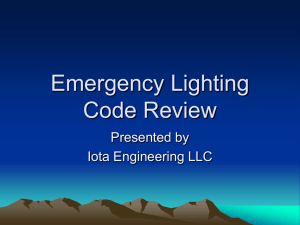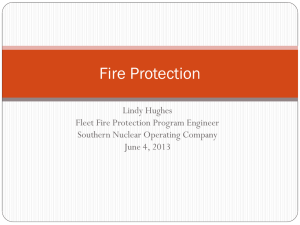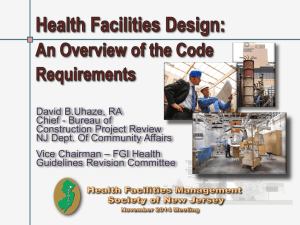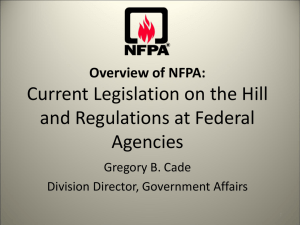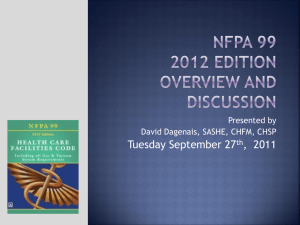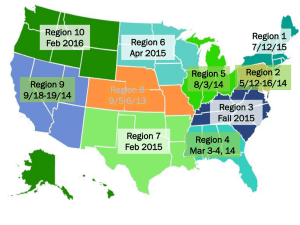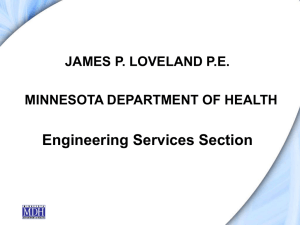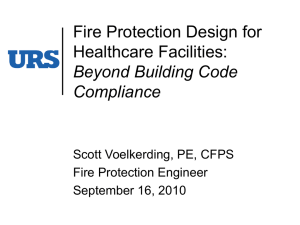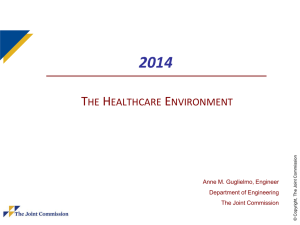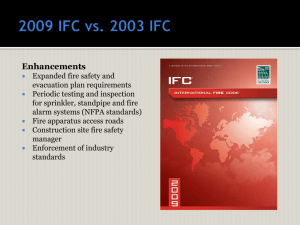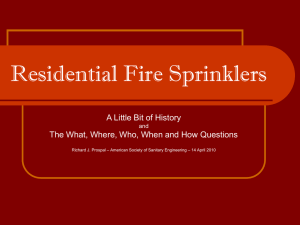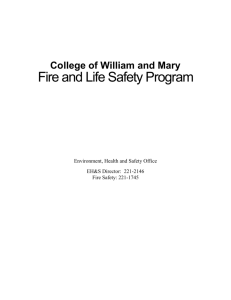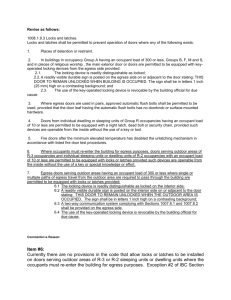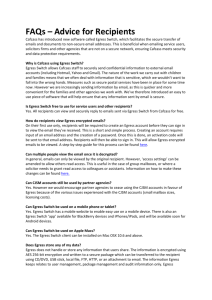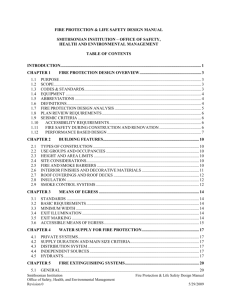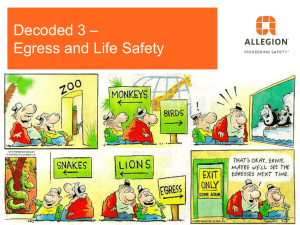Impact of CMS
advertisement
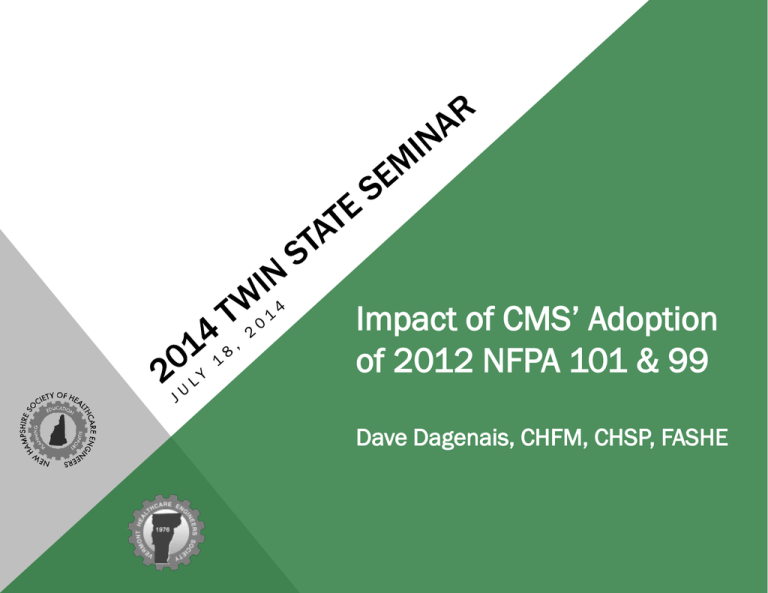
Impact of CMS’ Adoption of 2012 NFPA 101 & 99 Dave Dagenais, CHFM, CHSP, FASHE CMS IS PROPOSING TO ADOPT NFPA 101 & NFPA 99 WITH THE FOLLOWING MODIFICATIONS ADOPTION, CHANGE IN DEFINITION Changes definition of “health care occupancy” from applying to “4 or more patients” to “regardless of the number of patients served” Could apply to hospital outpatient depts. Based on billing of hospital-based provider services in outpatient buildings ROLLER LATCHES Does not allow the exception in the LSC that permits use of roller latches CMS standards have permitted use of roller latches for more than 20 years Roller latches have become common in behavioral health ALCOHOL BASED HAND RUBS 2012 LSC allows ABHRs Accepts 2012 LSC requirements but adds “if installed to prohibit inappropriate access” – Interpretive guidance is needed to determine what this means. SPRINKLER 4-HOUR RULE NFPA 25 formerly required evacuation or fire watch of facilities if a sprinkler system was out of service for more than 4 hours in a 24-hour period. This has been changed in NFPA 25 to 10 hours to accommodate a “work day.” CMS proposes going back to the 4-hour period. CMS WILL REQUIRE OR SMOKE VENTS Required when flammable anesthetics were used Removed as operating room ACH increased, sprinkler requirements were added, severity of fire risk and extent decreased 36" SILL HEIGHT Okay for new construction As written will apply to existing construction How many existing facilities will this affect? What is the cost to fix this condition? Is it worth it? Staff should not break out windows during a fire Patients should not be evacuated through windows ADOPTION OF NFPA 99, 2012 EDITION Directly adopts NFPA 99: Health Care Facilities Code Except chapters: Chapter 7 Chapter 8 Chapter 12 Chapter 13 = = = = IT and Nurse Call Plumbing Emergency Preparedness Security S&C 13-58 Issued August 30th, 2013 Covers several “categorical waivers” MEDICAL GAS MASTER ALARMS Allows substitution of a centralized computer system for (one) Category 1 medical gas master alarm. OPENINGS IN EXIT ENCLOSURES Permits existing openings in exit enclosures to mechanical equipment spaces if they are protected by firerated door assemblies. EMERGENCY GENERATORS AND STANDBY POWER SYSTEMS Reduces the annual diesel-powered generator exercising requirement from two (2) continuous hours to one hour and 30 minutes. DOORS Allows more than one delayed-egress lock in the egress path where the clinical needs require specialized security measures or when a patient requires specialized protective measures for safety. SUITES Allows: 1. Suite to suite egress 2. Allows one of the two required exits to enter an exit stair 3. Increase the sleeping room suite size up to 10,000 sq. ft. EXTINGUISHING REQUIREMENTS Allows: 1. Reduction in the testing frequencies for sprinkler system vane-type and pressure switch type waterflow alarm devices to semiannual, 2. Electric motor-driven pump assemblies to monthly. CLEAN WASTE & PATIENT RECORD RECYCLING CONTAINERS Allows the increase in size of containers used solely for recycling clean waste or for patient records awaiting destruction outside of a hazardous storage area to be a maximum of 96gallons S&C 12-21 Corridor Width New “Effective” Corridor width 5’-0” 8’-0” Fixed furniture allowed Rolling carts, equipment and movement aids allowed Bench c.c. DECORATIONS Increases the amount of wall space that may be covered by combustible decorations 20% Not Sprinklered 30% Sprinklered 50% Sprinklered in patient room (less than 4) FIREPLACES Allows the installation of direct vent gas fireplaces in smoke compartments containing patient sleeping rooms and the installation of solid fuel burning fireplaces in areas other than patient sleeping areas S&C 13-25 OR Relative Humidity lowering the humidity requirement for operating rooms and other anesthetizing locations from at least 35percent to at least 20 percent. HOW TO REQUEST A CATEGORICAL WAIVER Document your desire and that you comply with the waiver provisions in your policy and procedures manual. Verbally announce that you are requesting the waivers at each entrance interview of a survey Check with your State Agency and verify the waivers will be accepted for licensing Indicate Life Safety waiver requests in your BBI Indicate Environment of Care waiver requests in your management plan ITEMS DELETED-OVERVIEW Laboratory requirements Manufacturers’ requirements on electrical equipment Annexes B, D, & E are deleted. They are technology not used any longer. All of the Occupancy Chapters NEW ITEMS-OVERVIEW Standard becomes a Code Fundamentals Chapter on Risk Information Technology and Communication Systems Plumbing Heating Emergency Management (new requirements) Security Fire Protection unique to Health Care Facilities HOW THE CODE WORKS Determine the worst case procedure. Select the Risk Category. Select the systems or procedures in the Code that are prescribed by that level of risk Category ADMINISTRATION (CHAPTER 1) To provide minimum requirements for the: Performance Maintenance, Testing and Inspection Safe practices based on risk ADMINISTRATION (CHAPTER 1) Applies to all health care facilities (other than home health) Applies to NEW construction and equipment only altered or renovated or modernized Some testing and maintenance requirements apply to existing Emergency Management and Security apply to existing REFERENCED PUBLICATIONS (CHAPTER 2) All Referenced publication material has been updated to most current version DEFINITIONS (CHAPTER 3) 3.3.9 Anesthetizing location – General anesthesia 3.3.17 Battery powered lighting units – NFPA 70 3.3.63 General anesthesia and levels of sedation Deep sedation General anesthesia Minimal sedation Moderate sedation 3.3.109 Medical support gas FUNDAMENTALS (CHAPTER 4) Category 1 - Facility systems in which failure of such equipment or system is likely to cause major injury or death of patients or caregivers shall be designed to meet system Category 1 requirements as defined in this code. FUNDAMENTALS (CHAPTER 4) Category 2 - Facility systems in which failure of such equipment is likely to cause minor injury to patients or caregivers shall be designed to meet system Category 2 requirements as defined in this code. FUNDAMENTALS (CHAPTER 4) Category 3 - Facility systems in which failure of such equipment is not likely to cause injury to the patients or caregivers, but can cause patient discomfort shall be designed to meet system Category 3 requirements as defined in this code. FUNDAMENTALS (CHAPTER 4) Category 4 -Facility systems in which failure of such equipment would have no impact on patient care shall be designed to meet system Category 4 requirements as defined in this code. FUNDAMENTALS (CHAPTER 4) 4.2* Risk Assessment. Categories shall be determined by following and documenting a defined risk assessment procedure. A.4.2 Risk assessment should follow procedures such as those outlined in ISO 31010, NFPA 551, SEMI S10-0307 or other formal process. The results of the assessment procedure should be documented and records retained. GAS AND VACUUM SYSTEMS (CHAPTER 5) Adding testing and inspection requirements on existing non-stationary medical booms Testing per manufacturers recommendations, every 18 months or based on risk assessment. GAS AND VACUUM SYSTEMS (CHAPTER 5) 5.1.4.8 Zone Valves. All station outlets/inlets shall be supplied through a zone valve as follows: The zone valve shall be placed such that a wall intervenes between the valve and outlets/inlets that it controls. ELECTRICAL SYSTEMS (CHAPTER 6) “Wet Location” changes to “Wet Procedure Location” throughout the entire document ELECTRICAL SYSTEMS (CHAPTER 6) Requires that overcurrent protection devices only be accessible to authorized personnel and not permitted in public access spaces ELECTRICAL SYSTEMS (CHAPTER 6) Increases minimum number of receptacles General Care – From 4 to 8 Critical Care – From 6 to 14 Operating Rooms – New requirement of 36 ELECTRICAL SYSTEMS (CHAPTER 6) Permits fuel transfer pumps, receptacles, ventilation fans, louvers and cooling systems related to generators to be added to the life safety or critical branch (deleted from equipment branch) ELECTRICAL SYSTEMS (CHAPTER 6) Monthly Generator Testing - 10 second transfer not required (Annual Confirmation) ELECTRICAL SYSTEMS (CHAPTER 6) New section which permits switches in lighting circuits connected to Life Safety and critical branch as long as they don’t serve as illumination of egress as required by NFPA 101 ELECTRICAL SYSTEMS (CHAPTER 6) New section on campus electrical systems being added Attempts to clear up conflicts with NEC ELECTRICAL SYSTEMS (CHAPTER 6) Requires all operating rooms to be wet procedure locations (unless risk assessment is done) ELECTRICAL SYSTEMS (CHAPTER 6) Permits isolated power or ground fault protection within operating rooms ELECTRICAL SYSTEMS (CHAPTER 6) Eliminates emergency system heading and equipment system heading and utilizes branches Life Safety Critical Equipment ELECTRICAL SYSTEMS (CHAPTER 6) Added text to permit a 0.1 second delay for selective coordination IT AND COMMUNICATION (CHAPTER 7) New chapter covers IT rooms Fire protection Nurse call Emergency call Staff emergency assistance PLUMBING (CHAPTER 8) TIA will cover plumbing requirements Essentially will refer to other model codes or standards TIA 8.1.4.1 Nonmedical Compressed Air 8.3.1 Potable Water. Potable water systems shall comply with applicable plumbing codes. 8.3.2 Nonpotable Water. Nonpotable water systems shall comply with applicable plumbing codes. 8.3.3 Water Heating. Maximum hot water temperatures shall comply with applicable plumbing codes. 8.3.4 Water Conditioning. Water shall be treated or heated to control pathogens in the water. 8.3.5 Nonmedical Compressed Air. 8.3.7 Grease Interceptors. 8.3.10 Grey Waste Water. 8.3.11 Clear Waste Water. HEATING, VENTILATION AND AIR CONDITIONING (CHAPTER 9) New TIA will cover oxygen transfilling room requirements Waste Anesthesia Gas Disposal (WAGD) TIA 9.3.3 Commissioning 9.3.7 Medical Gas Storage or Transfilling. 9.3.7.5.2 Natural Ventilation 9.3.7.5.3 Mechanical Ventilation. 9.3.8 Waste Gas. 9.3.9 Medical Plume Evacuation ELECTRICAL EQUIPMENT (CHAPTER 10) Chapter reorganized Testing requirements have been updated Leakage requirements have been updated MULTIPLE OUTLET CONNECTIONS (POWER TAPS) 10.2.3.6 • Allows power taps that meet the following o Permanently attached o Some of load not over 75% o Cord meets NFPA 70 o Electrical integrity is regularly verified and documented o When new equipment is attached, integrity must be verified again. GAS EQUIPMENT (CHAPTER 11) 11.3.2.5 Temperature limitations to storage of cylinders must comply with 5.1.3.3.1.7 (temperatures not to exceed 54o C or 130o F. 11.4.3.1.1 Specifies the requirements for carts and hand trucks that transport cylinders (must be self supporting and have appropriate chains.) EMERGENCY MANAGEMENT (CHAPTER 12) Completely rewritten and expanded for 2012 Two categories of risk In-patient facility is expected to be operable In-patient and out-patient areas that augment the critical mission but not receive in-patients Requires a Hazard Vulnerability Analysis (HVA) Natural Hazards Human-caused Events Technological Events EMERGENCY MANAGEMENT (CHAPTER 12) Requires plans to manage resources and assets Requires Exercises Requires Evaluation of Exercises Special Care was taken to avoid conflicts with the Joint Commission and CMS SECURITY MANAGEMENT (CHAPTER 13) Planning for protection of the Staff and Facility beyond disasters Requires a Security Vulnerability Assessment (SVA) Requires a responsible person Education requirements of security staff Customer Service Emergency Procedures Use of Force De-escalation Use of Restraints SECURITY MANAGEMENT (CHAPTER 13) Requires procedures for Hostage Bomb Threat Workplace Violence Disorderly Conduct Restraining Orders SECURITY MANAGEMENT (CHAPTER 13) Identifies known security sensitive areas Emergency Departments Pediatric and Infant Care units Medication Storage Clinical Labs Forensic Patient Treatment Areas Dementia or Behavior Health Units Communications, data infrastructure and medical records SECURITY MANAGEMENT (CHAPTER 13) Other subjects covered Media control Crowd control Security equipment – follow NFPA 731 Employee practices Security operations HYPERBARIC FACILITIES (CHAPTER 14) Piping requirements have been updated New requirements for location of shutoff valve Updated requirements for reserve to central supply system New requirements for hyperbaric medical air system FEATURES OF FIRE PROTECTION (CHAPTER 15) Chapter applies to new and existing Pulls most of text from NFPA 101 Fire alarm and detection Protection of gas cylinder storage HVAC detection requirements Defend in place requirements Closets sprinkler exception (less than 6 sq. ft.) Orientation and training requirements DEFINITIONS (CHAPTER 3) Normally occupied building service equipment support area People not present on a regular basis MEANS OF EGRESS (CHAPTER 7) 7.2.1.5.1 • Door leaves shall open readily from the egress side. 7.2.1.5.2 • The requirements of 7.2.1.5.1 shall not apply when door is exposed to elevator temperature in compliance with listing. MEANS OF EGRESS (CHAPTER 7) 7.2.1.5.10.6 Two release operation is permitted on existing doors when an occupant load does not exceed three providing it does not require simultaneous operation. EXISTING HEALTHCARE OCCUPANCY (CHAPTER 19) 19.2.2.2.5.1 • Door locking is permitted for clinical or security needs provided staff can readily unlock doors. o Provisions must exist for rapid removal • Remote control locks • Keys carried by staff • Other reliable means o Only one lock per door o More than one permitted with AHJ DELAYED EGRESS LOCKS (CHAPTER 19) • More than one delayed egress lock is permitted in the egress path DELAYED EGRESS LOCKS (CHAPTER 19) 19.2.3.4 • Permits items in corridor such as wheeled equipment, carts in use, medical emergency equipment, patient lift and transport equipment and fixed furniture as long as it does not reduce the corridor width to less than 5 feet. SUITES (CHAPTER 19) 19.2.5.7.2.3 • Permits sleeping suites to be 7500 sq. ft. where protected with sprinklers. • Can go to 10,000 sq. ft. o Direct visual supervision o Supervised sprinkler system o Automatic smoke detection SUITES (CHAPTER 19) Permits suites to egress through adjoining suite and more than one intervening room. ALCOHOL BASED HAND RUB (CHAPTER 19) 19.3.2.6 • Exempts one dispenser per room from the 10gallon per smoke compartment requirement. DECORATIONS (CHAPTER 19) 19.7.5.6 Increases the amount of wall space that may be covered by combustible decorations • 20% Not Sprinklered • 30% Sprinklered • 50% Sprinklered in patient room (less than 4) SPRINKLERS (CHAPTER 19) 19.3.5.10 Sprinklers not required in clothes closets in patient sleeping rooms where the area does not exceed 6 sq. ft. CONTAINERS FOR RECYCLING, CLEAN WASTE OR PATIENT RECORDS (CHAPTER 19) 19.3.5.10 May be between 32 – 96 gallons if they meet FM standard 6921. Thank You Questions? Dave Dagenais, CHFM, CHSP, FASHE
